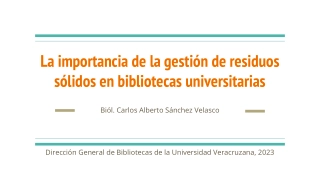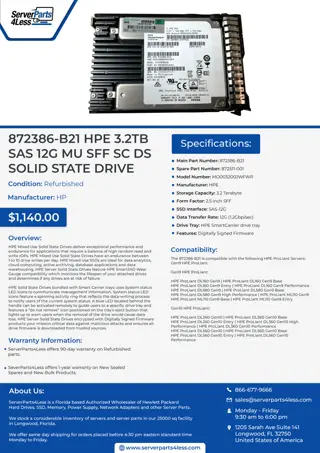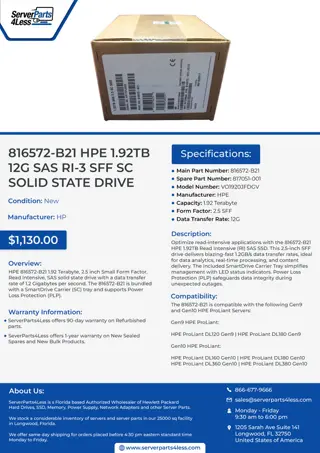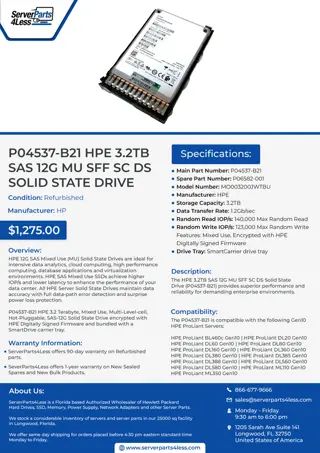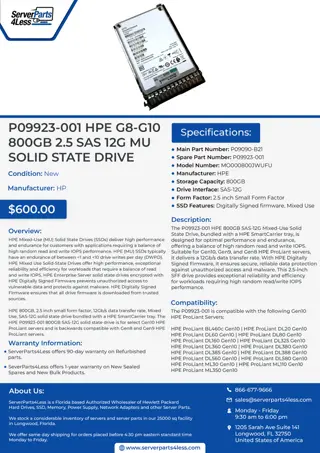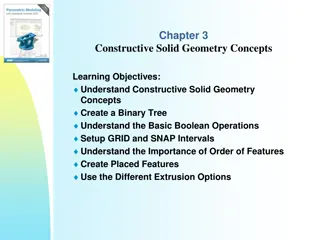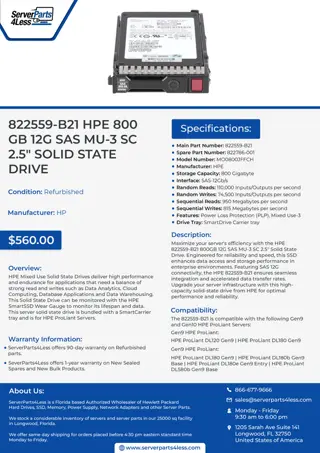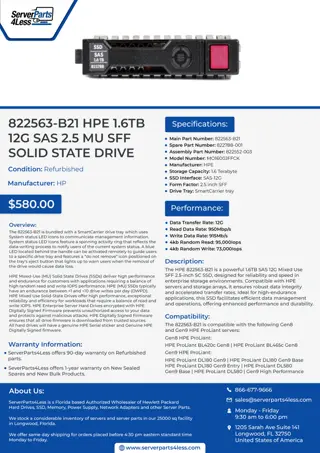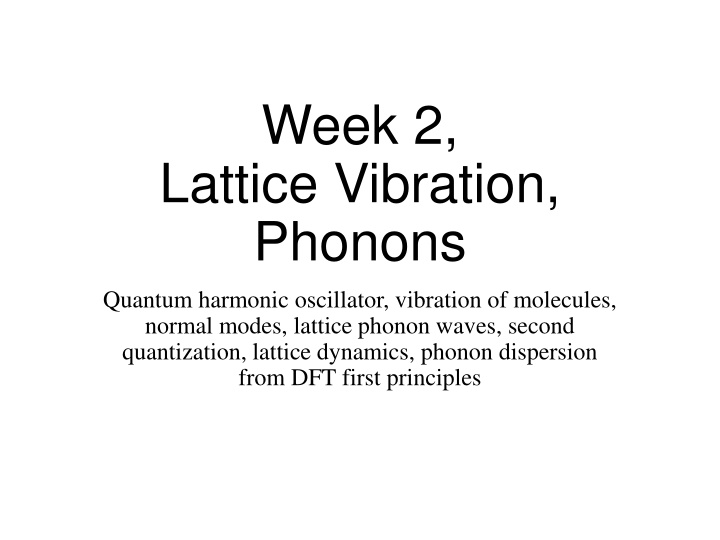
Understanding Lattice Vibration and Molecular Dynamics
Explore the fascinating world of lattice vibration, phonons, quantum harmonic oscillators, molecular vibrations, and group theory with a focus on normal modes and second quantization. Discover the principles behind the phonon dispersion from DFT and molecular vibration in water molecules.
Download Presentation

Please find below an Image/Link to download the presentation.
The content on the website is provided AS IS for your information and personal use only. It may not be sold, licensed, or shared on other websites without obtaining consent from the author. If you encounter any issues during the download, it is possible that the publisher has removed the file from their server.
You are allowed to download the files provided on this website for personal or commercial use, subject to the condition that they are used lawfully. All files are the property of their respective owners.
The content on the website is provided AS IS for your information and personal use only. It may not be sold, licensed, or shared on other websites without obtaining consent from the author.
E N D
Presentation Transcript
Week 2, Lattice Vibration, Phonons Quantum harmonic oscillator, vibration of molecules, normal modes, lattice phonon waves, second quantization, lattice dynamics, phonon dispersion from DFT first principles
Harmonic oscillator x 2 1 2 1 2 1 2 p M p M k = + = + = = = 2 2 2 2 2 , , H kx u u u M x u 2 M 1 i 1 2 dA dt = = + [ , A H ] Bohr-Sommerfeld: 2 pdx n 2 d u dt i t + = + = = + = + 2 0 or 0 c.c. | |cos( ) M x kx u u Ae A t 2 E 5 2 ( ) ( ) [ , ] [ , ] x p = = = + = , u u i u a a u i a a 2 2 3 2 ] 1 = [ , a a E n 1 2 1 2 = + = + = , 0,1,2, H a a E n n 1 2 n = = = + + , 1 , 1 1 H n a n n n a n n n n x 1[ , i da dt i t = = = ] ( ) a H i a a t ae
Annihilation and creation operators Energy E = Let , then is an eigen state with energy H E a E = + = + Proof: ( ) ( ) ( ) H a Ha aH aH E a E = = = = [ , [ , ] H a ] [ , ] a a a 1 a a a a aa = a a ? , ] [ , ] AB C = + [ , ] use Leibniz rule: [ [ , ] A B C a A C B + Similarly is an eigen state with energy a E 2 = ( , = = The sequence must terminate due to | ) ( , ) 0 a a a a a a a 1 2 = = = Ground state (vacuum): 0 0, 0 0 , 0|0 1 a H
Molecular vibration, normal mode u u 1 2 1 2 1 2 du dt V 2 = + = = = = 2 T , , , H p u Ku p K u u M x ij u u i j u N = T K u K i t + = = Q e = 2 0, try Ku = u K 1, n ( ) 2, n = = = = T T , 1, ( ), , , , u UQ t U U U I 1 2 n N , N n 2 1 0 0 0 0 0 0 2 2 0 0 0 1 2 N ( ) ( ) = = = + = + 2 n T 2 2 n 2 n n , , U KU H P Q Q a a n n n 2 0 0 = 1 n n 2 N 0
Water molecule H 1 2 ( ) ( ) 2 2 = + + V V K r r 0 1 2 r ?1 1 2 K ( ) 2 + + r r ' K r K 1 2 e r O ? ( )( ) + + r r r 1 2 r e ?2 = = 8.454 (units newton/cm) 0.761 = = K K r H ' 0.101 0.228 K K = 104.48 r = r = 0.9576 r A 1 2 r
Molecular vibration, group theory, H2O A1A1 Symmetry group C 2 v z r : relative dispacements form a direct product of atom site permutation D and = r i ij vector ( , , ) x y z H O 2 x = + B + a.s. mol.vib. = (2 = 2 vec ) trans A rot + B1 + ) ( + + ) ( + + ( ) A B B B A B B A B B 1 1 1 1 2 1 1 2 2 1 2 A v 1 -1 -1 1 1 v 1 -1 1 -1 3 C2v z Rz x, Ry y, Rx E 1 1 1 1 3 C2 1 1 -1 -1 1 1 1 A1 A2 B1 B2 a.s = = + + = + + , A B B A B B vec trans 1 1 2 rot 2 1 2 = = = , , A X X B B A B B A 1 1 1 1 1 2 2
Direct product representation 1 0 0 0 0 1 0 1 0 0 0 0 x 0 1 1 0 = = 0 0 , x x x 0 x ( ) = = = (1) ij (2) (1) (2) ( ) A ( ) A D ( ) A ( ) A Tr ( ) ( ) A ( ) A D D D A , i j 1 N = = ( ) a ( ) a * ( ) A ( ) A ( ) A ( ) A m m a a a A Use orthogonality of irreducible representions ( ) ( ) A = ( ) a * ( ) b A A N ab
Lattice vibration, 1D chain kk xl-1xlxl+1 x0 xN-1xN =x0 a: lattice constant 1 M 1 2 1 1 N N ( ) 2 = + = = 2 l , , 0,1,2, 1 H p k x x R la l N + 1 l l l 2 = = 0 0 l l 2 d x dt ( ) ( ) = l M k x x k x x + 1 1 l l l l 2 1 N 1 N 2 1 N k = = = = iqR iqR ( ) x q , ( ) x q e , , 0,1, 1 x e x q k N l l l l Na = 0 l q 2 ( ) 4 M d x q dt k qa ( ) q x q = = 2 ( ), ( ) q sin 2 2 0 2 /a q
Normal mode coordinates, second quantization of 1D chain 1 N = = = + iqR iqR ( ) ( ) a q e h.c. u M x Q q e l l l l 2 ( ) q N q q 2 Na = = = i.e., ( ) ( ), integer, Q q M x q q R la l 1 2 ( ) = + ( ) q Q q Q q = 2 ( ) ( ) ( ) ( ) H P q P q H H q 1 2 = + ( ) q ( ) ( ) a q a q q = [ ( ), ( ')] a q a q ' qq ( ) = + = = ( ) ( ) a q ( ) , [ ( ), ( ')] [ a q a q ( ), ( ')] 0 Q q a q a q a q 2 ( ) q = = = ( ) ( ), ( ) ( ), [ ( ), ( ') ] Q q P q Q q Q q P q P q i ' qq
1D chain with two kinds of atoms l-1 ll+1 kk k M1 M2 a = = + ( 2 x ) ) LO M x M x k x k x x x 1,2 1 ,1 ,1 ,2 l l l l + ( 2 x 1,1 + 2 ,2 ,1 ,2 l l l l M x ( ) ( ) u q u q 1 N 1 N 1 ,1 l 1 = = = iqR ( ) u q , e R la l l M x = 0 l 2 2 ,2 l LA 2 M k k ( ) + iqa 1 e M M e e e e /a q 1 1 2 1 1 = = 2 ( ) D q 2 M k k ( ) + iqa 1 2 2 e M M 2 1 2
General lattice, forces, eqn = + R r = + + R R 1 1 l a a 3 3 l a : unit cell, real space lattice: l l 2 2 lj l j l : -th atom in unit cell : , , or Cartesian component : coo lj lj R x + rdinate of -th cell, -th atom, in direction j j x y z l j 2 1 2 V ( ) + = + + V { } ({ }) R R x V x x ' ' ' l j lj lj lj ' ' ' l j R R ; ' ' ' l j lj lj a2 2 ({ }) R R V V = = 0, K , ' ' ' l j lj ' ' ' l j R R xlj lj lj rj = 0 x lj Rl 2 a1 d x dt V x lj = = M K ' ' ' l j x , ' ' ' l j j lj 2 ' ' ' l j lj = = lattice translational invariance: ( ') K K K l l , ' ' ' l j l l j + + , ' ' j '' , ' l '' ' ' l j lj j
Dynamic matrix 2 d x dt lj = ( ') M K l l x , ' ' j ' ' ' l j j j 2 ' ' ' l j i t q R . i = = try plane wave: const ( ) q e u M x e lj lj j lj j 1 M 1 M ( ) i t i t 2 q R q R . . i i = q ( ) q ( ) ( ') M i e e K l l e e ' ' l j lj , ' ' j ' ' j j j j ' ' ' l j ' j j q ( ) q ( ) ( ) q q 1 ,1 x x D D 1 ,1 x y D ( ) ( ) q e e 1 x 1 ,1 y x 1 y = = = 2 ( ) , q ( ) q , e D e e D ( ) q D , ' ' j j ( ) q ( ) q Nz Nz D e , Nz 1 + q R r r ( ) i = = ( ) q ( ) q ( ) q ( ) l e , D K D D ' l j j , ' ' j , ' ' j j j M M l ' j j
Diamond lattice, structure Space group Fd 3m (No. 227) (nonsymmorphic) Point group Oh (m3m) Two fcc displaced along (1,1,1) by 1/4 lattice constant
Character table for Oh 3C2= (C4)2i linear, rotations E 8C3 6C2 6C4 6S4 8S6 quadratic 3 h 6 d A1g ( 1) 1 1 1 1 1 1 1 1 1 1 x2+y2+z2 A2g ( 2) 1 1 -1 -1 1 1 -1 1 1 -1 (2z2-x2-y2, x2-y2) Eg ( 12) 2 -1 0 0 2 2 0 -1 2 0 T1g ( 15 ) 3 0 -1 1 -1 3 1 0 -1 -1 (Rx, Ry, Rz) T2g ( 25 ) 3 0 1 -1 -1 3 -1 0 -1 1 (xz, yz, xy) A1u ( 1 ) A2u ( 2 ) Eu ( 12 ) 1 1 2 1 1 -1 1 -1 0 1 -1 0 1 1 2 -1 -1 -2 -1 1 0 -1 -1 1 -1 -1 -2 -1 1 0 T1u ( 15) 3 0 -1 1 -1 -3 -1 0 1 1 (x, y, z) T2u ( 25) 3 0 1 -1 -1 -3 1 0 1 -1
Run QE at HPC (e.g., atlas9.nus.edu.sg) Setup the proper running environment for QE by issuing two linux commands: source /etc/profile.d/rec_modules.sh module load espresso6.5-Centos6_Intel The QE binary is then available as pw.x (for DFT plane wave self consistency) and ph.x (DFT perturbative phonon calculation)
Quantum Espresso (QE) for phonon mode at point Step 1: run pw.x at the equilibrium structure mpirun np 8 pw.x in scf.in > out Step 2: run ph.x to obtain frequencies and eigenmodes. mpirun np 8 ph.x in ph.in > phout See also https://www.quantum-espresso.org/resources/tutorials/shanghai- 2013/hands-on-phonons/phonons_tutorial_shanghai1.pdf
Input file scf.in for pw.x &control prefix = 'diamond' calculation = 'vc-relax' restart_mode = 'from_scratch' pseudo_dir = './' / &system ibrav = 0 celldm(1)=6.75870348 nat = 2 ntyp = 1 ecutwfc = 60.0 / &electrons conv_thr = 1.0d-10 / &IONS ion_dynamics = 'bfgs' / &CELL cell_dynamics = 'bfgs' cell_dofree = 'ibrav' / CELL_PARAMETERS alat 0.0000000 0.5000000 0.5000000 0.5000000 0.0000000 0.5000000 0.5000000 0.5000000 0.0000000 ATOMIC_SPECIES C 12.011 C.UPF ATOMIC_POSITIONS alat C 0.0000000 0.0000000 0.000000 C 0.250000 0.25000000 0.250000 K_POINTS automatic 10 10 10 0 0 0
Input file ph.in for ph.x phonons at Gamma point &INPUTPH prefix = 'diamond' epsil = .true. fildyn = 'dyn.G' tr2_ph = 1.0d-14 / 0.0 0.0 0.0 The normal mode displacements are reported in the dyn.G file.
Phonon dispersion for diamond Three units in common use for frequency 1 THz ( /(2 )) = 33.356 cm-1 ( /(2 c)) = 4.14 meV ( )


